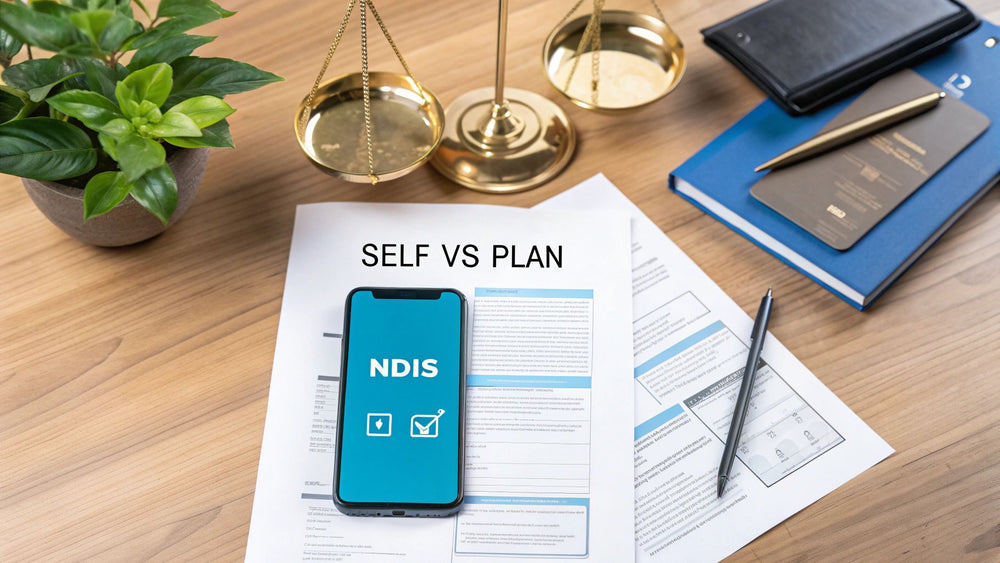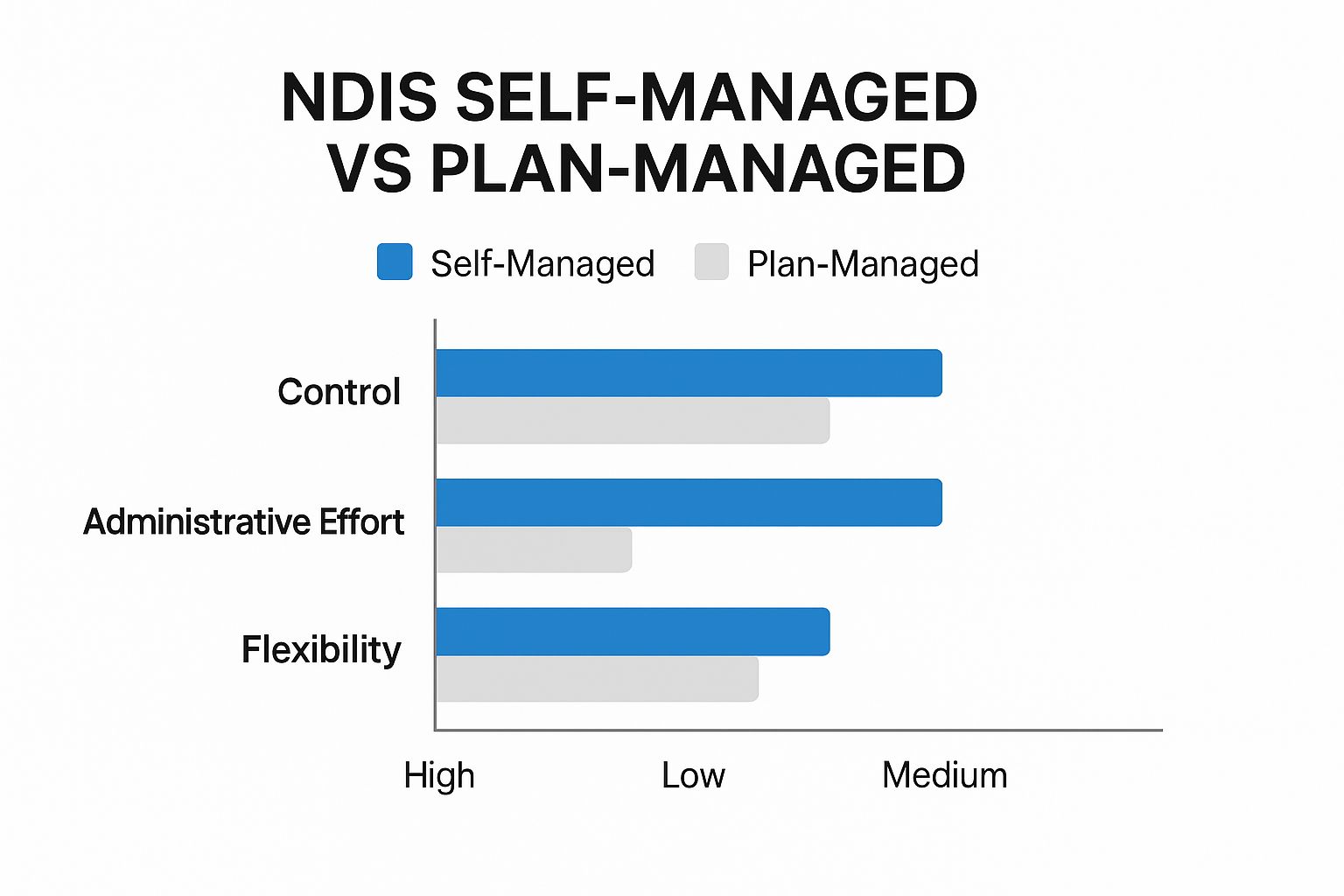NDIS Self Managed vs Plan Managed An Expert Comparison

When you’re weighing up NDIS self-management versus plan management, the core difference really boils down to one simple question: who’s going to handle the money and the paperwork?
With self-management, you’re in the driver's seat. You have the ultimate control and flexibility, but that also means you're responsible for all the financial admin that comes with it. Plan management, on the other hand, gives you that same flexibility but outsources the financial tasks to an expert, freeing you up to focus on your supports.
NDIS Self-Managed vs Plan-Managed: Key Differences
Choosing how to manage your NDIS funds is a big decision, and it’s one that will shape your entire NDIS journey. It directly impacts your day-to-day responsibilities, the providers you can work with, and the level of control you have over your supports. Getting your head around the trade-offs between self-management and plan management is the crucial first step.

When you self-manage your NDIS plan, you get complete autonomy. This means you can choose any provider you want—whether they are registered with the NDIS or not—and even negotiate rates with them. It offers incredible flexibility to build a support team that's perfect for you. But with this freedom comes the responsibility of managing every dollar, paying invoices, and keeping meticulous records.
Plan management offers a popular middle ground. You still get the freedom to choose from a wide range of providers (both registered and unregistered), but a professional plan manager takes care of all the financial heavy lifting. They handle paying your invoices, tracking your spending, and giving you regular budget updates, taking the administrative stress off your shoulders.
At a Glance: Self-Management vs. Plan Management
To make things a bit clearer, let's break down the main differences side-by-side. This table gives you a quick snapshot of what each option involves.
| Feature | Self-Management | Plan Management |
|---|---|---|
| Provider Choice | Any provider (NDIS registered or not) | Any provider (NDIS registered or not) |
| Invoice Payments | You are responsible for paying all invoices. | Your plan manager pays all your invoices for you. |
| Record Keeping | You must keep all financial records yourself. | Your plan manager handles all record keeping. |
| Budget Tracking | You need to track your own spending. | Your plan manager provides budget updates and help. |
| Pricing Rules | You can negotiate rates with providers. | You must adhere to the NDIS Pricing Arrangements. |
Ultimately, comparing the two options helps you decide what role you want to play in managing your plan's funds.
The essential choice is this: Do you want to be the hands-on financial manager of your plan, or would you prefer to be the director of your services while someone else handles the books?
This decision goes far beyond just paperwork; it’s about where you want to invest your time and energy. If the financial side of things feels a bit overwhelming, remember that a support coordinator can be a fantastic ally in helping you explore these options. You can find out more about maximising your NDIS plan with the essential role of support coordination in our detailed guide.
How NDIS Self-Management Puts You in Control
When you choose to self-manage your NDIS plan, you're essentially stepping into the driver's seat. It's a hands-on approach that puts you at the very centre of every decision, giving you direct control over your funding and how you use it to chase your goals. This path is really for those who crave the highest level of independence and feel ready to handle the responsibilities that come with it.
The biggest drawcard for self-management is, without a doubt, the freedom of choice it offers. You aren't tied down to using only NDIS-registered providers. This simple fact blows the doors wide open, letting you work with any professional or service you believe is the best fit, whether they're officially registered or not.
Practical Flexibility in Action
Think about it. You might find a fantastic local therapist who just gets you, but they haven't gone through the NDIS registration process. Or maybe you've found a piece of specialised equipment from a small, independent supplier who has a better price or a more suitable product. With self-management, navigating these situations is completely straightforward.
- Hire Anyone: You can directly find and pay a support worker, therapist, or even a gardener based on their skills and how well you connect with them.
- Negotiate Rates: You have the ability to discuss and agree on service rates directly with your chosen providers. This can sometimes make your funding stretch a lot further.
- Buy from Anywhere: You’re free to purchase low-cost assistive technology or other supports from any everyday retailer, not just from a list of approved vendors.
This degree of control means you can build a support system that is genuinely tailored to your life, your needs, and your personal preferences.
The Responsibility of Being in Charge
Of course, with this much control comes a fair bit of accountability. As a self-manager, you're also taking on the role of financial administrator for your own plan. This means you'll be handling a few crucial tasks to make sure your funding is managed properly and transparently.
When you self-manage, you become the chief financial officer of your own plan. This means you are responsible for budgeting, paying providers, and keeping detailed records for potential audits by the NDIA.
Your key duties will involve keeping an eye on your budget through the myplace portal, paying your provider invoices on time, and carefully holding onto all your receipts and paperwork. It's also really important to have clear service agreements with your providers. If you need a hand with this, have a look at our helpful guide to your NDIS service agreement to ensure everyone is on the same page.
While this approach definitely requires you to be organised and comfortable with managing money, the reward is a support structure that you have designed from the ground up.
How NDIS Plan Management Offers Supported Choice
Think of plan management as a popular middle-ground option. It sits comfortably between the complete independence of self-managing and the more hands-off approach of having the NDIA manage your funds. Many people find it’s the ‘best of both worlds’—you get the choice and control that comes with self-management, but without the personal financial admin.
This is a great fit if you value flexibility but would rather not deal with paying invoices and tracking budgets yourself.

When you opt for plan management, you bring a plan manager on board to act as your financial intermediary. Their core job is to handle the money side of your NDIS plan. This includes paying your support providers, keeping an eye on your budget, and sending you regular statements to show you where your funds are going.
What does this mean for you? You still have the freedom to choose your providers, whether they are registered with the NDIS or not. That’s the same level of flexibility you get with self-management. The main difference is the process: once you’ve received a service and approved the invoice, you just pass it on to your plan manager. They take care of the rest.
The Role and Duties of a Plan Manager
A plan manager's duties are very specific. They are there to support the choices you make, not to make decisions for you. This distinction is crucial, as it keeps you firmly in the driver's seat of your support network. As our insights on person-centred approaches explain, this is a new benchmark for disability services and a fundamental part of the NDIS philosophy.
So, what does a plan manager actually do?
- Pays Invoices: They take the invoices from your providers and pay them directly from your NDIS plan funds.
- Tracks Budgets: They monitor your spending across your different support categories and give you monthly updates.
- Keeps Financial Records: They handle all the financial paperwork and record-keeping required for potential NDIS audits.
This model of supported choice lifts a huge administrative weight off your shoulders. You can concentrate on getting the right supports in place, not on getting bogged down in paperwork.
Choosing plan management means you direct the 'what' and 'who' of your supports, while your plan manager handles the 'how' of paying for them. You maintain full autonomy over your services without the stress of managing the money.
Most importantly, the funding for a plan manager is allocated separately by the NDIA. It comes from a support category called 'Improved Life Choices'. This means their service comes at no out-of-pocket cost to you. It doesn't take a single dollar away from the funding you need for other crucial supports like therapy or in-home care. It's simply an extra layer of support built into the system to make your NDIS journey that much easier.
Comparing Your Responsibilities and Flexibility
Deciding between NDIS self-management and plan management really boils down to a practical trade-off. It’s not just about who pays the bills; it's about how hands-on you want to be with the financial side of your plan and how much freedom you truly need. Let's move past a simple pros-and-cons list and dig into the specific tasks and flexibility each option brings to the table.
Your choice here directly shapes your day-to-day role. If you self-manage, you are the financial controller, responsible for every single transaction. With plan management, you're more like the director of your services, delegating the financial admin to a trusted partner so you can focus on the supports themselves.
Financial and Administrative Tasks
The biggest, most immediate difference between the two is who handles the money and the mountain of paperwork that comes with it. These daily responsibilities are at the very heart of the NDIS self-managed vs plan-managed decision.
Under self-management, you are responsible for:
- Paying Invoices: You’ll need to pay providers directly and on time, whether that’s through bank transfers or using a credit card.
- Claiming Reimbursements: After you've paid an invoice, it's on you to log in to the myplace portal and submit a payment request to be reimbursed by the NDIA.
- Record Keeping: You are legally required to keep detailed records of all your spending. This means holding onto invoices and receipts for a minimum of five years, just in case you're selected for an NDIS audit.
- Budget Management: It's up to you to actively track your spending against your plan's budget to make sure the funds last as long as they need to.
When you opt for plan management, all these duties are taken care of for you. Your plan manager steps in to handle the financial administration, freeing you from the stress of the paperwork.
This image really helps visualise the balance of control, effort, and flexibility you get with each approach.

As you can see, self-management gives you the most control and flexibility but demands a lot of administrative work. On the other hand, plan management strikes a balance by taking on that admin burden for you.
To see exactly what this looks like in practice, let's break down who does what.
Responsibility Breakdown: Self vs Plan Management
This table outlines the specific tasks and clarifies where the responsibility lies for each management style.
| Task | Self-Management Responsibility | Plan Management Responsibility |
|---|---|---|
| Paying Provider Invoices | You pay invoices directly from your own bank account. | Your plan manager pays providers on your behalf from your NDIS funds. |
| Claiming NDIS Funds | You submit payment requests via the myplace portal for reimbursement. | Your plan manager claims funds directly from the NDIA. |
| Tracking Budgets | You must monitor your own spending against your plan budgets. | Your plan manager tracks your budgets and provides you with regular statements. |
| Keeping Financial Records | You must keep all invoices and receipts for at least 5 years. | Your plan manager keeps all financial records for compliance and auditing. |
| Adhering to NDIS Rules | You are responsible for ensuring your purchases are "reasonable and necessary." | Your plan manager helps ensure claims align with NDIS guidelines. |
| Choosing Providers | You can use any provider, registered or not, and negotiate rates freely. | You can use any provider, registered or not, but must adhere to NDIS price limits. |
Ultimately, this breakdown shows that while both paths lead to choice and control, the journey's administrative demands are vastly different.
Flexibility and Provider Choice
Both self-management and plan management give you fantastic flexibility in choosing your providers. You're free to engage both NDIS-registered and non-registered services, which opens up a much wider market of supports that can be tailored perfectly to your life. The real difference comes down to pricing and how payments are handled.
A core differentiator is your ability to negotiate. With self-management, you can negotiate rates directly with providers, potentially making your funds go further. With plan management, you must adhere to the NDIS Pricing Arrangements and Price Limits.
This flexibility is clearly something people value. As of mid-2024, around 29% of NDIS participants choose to fully or partially self-manage their plans, a number that speaks volumes about the desire for direct control. This decision gives them access to a huge marketplace of over 215,000 active providers without being locked into NDIS price caps.
Plan management offers this exact same access but with the bonus of administrative support—a popular combination that has helped keep national plan utilisation rates steady at 78%.
At the end of the day, the right path depends on your confidence with financial tasks and how much time you can realistically commit. If you're looking for more guidance on building your support network, our article on choosing the right disability support in Adelaide can offer some valuable local insights to help you on your way.
Making the Right Choice for Your Situation
Choosing between self-management and plan management isn’t about which is objectively "better"—it's about which one is the right fit for you. The best path forward really hinges on your personal circumstances, how comfortable you are with admin, and the amount of time you can genuinely commit. It's a decision that will shape your entire NDIS journey.
To make things clearer, let's walk through a couple of common scenarios. Seeing how different people approach this can help you figure out where you might land.
The Confident Organiser
First, imagine someone we'll call 'The Confident Organiser'. This person is great with numbers, doesn't mind keeping records, and values having the absolute final say on their supports. They might want to hire a specific support worker directly—perhaps even paying them a little more than the standard rate—or purchase an item from a unique online shop that isn't NDIS-registered.
For this individual, self-management is a perfect match. They have the organisational skills and the time to handle the financial side of things. In exchange for managing invoices and keeping records, they get total freedom to negotiate rates and build their support team exactly how they envision it.
The Time-Pressed Advocate
Now, let's think about 'The Time-Pressed Advocate'. This person knows precisely what they need and may have found a fantastic local therapist who, for whatever reason, isn't registered with the NDIS. The catch? They have a packed schedule with zero time to spare for processing payments or tracking every dollar.
In this situation, plan management is the ideal solution. It offers the best of both worlds: they can still use their preferred unregistered provider, but a plan manager takes care of all the invoices and financial tracking. This frees them up to focus on what’s truly important—getting the best possible support.
The decision often comes down to this: Is your priority maximum control over the financial mechanics (self-management) or maximum choice with minimal personal admin (plan management)?
The NDIS is well-equipped to support either choice. As of March 2024, the scheme managed an annualised budget of around AUD 51 billion, with a bustling marketplace of over 21,000 active providers. With plan utilisation rates holding strong at 78%, it’s clear participants are effectively putting their funds to work, regardless of how they manage them.
Considering a Hybrid Approach
Remember, you're not locked into an all-or-nothing decision. A hybrid approach is also a completely valid option.
You could, for instance, self-manage one specific part of your budget where you want to directly negotiate terms, while letting a plan manager handle the rest. This gives you targeted control exactly where you want it without saddling you with all the administrative work. This kind of flexibility is key to making the NDIS work for you. For more localised advice, have a look at our guide on navigating NDIS in Adelaide for your disability support.
Answering Your NDIS Management Questions
Even after weighing up the pros and cons, you probably still have a few lingering questions about NDIS self-management versus plan management. That's completely normal. Let's tackle some of the most common queries we hear from participants, giving you direct answers to help you feel confident in your decision.

Sometimes, just getting clarity on a few key details can make the path forward much clearer. So, let’s get into it.
Can I Switch From Plan Managed to Self Managed?
Yes, you absolutely can. The NDIS is built to be flexible, so you're never permanently locked into one management style. While you can ask to change how your plan is managed at any time, the switch is usually easiest and smoothest during a scheduled plan review or reassessment.
To get the ball rolling, you just need to let the NDIA know you want to make the change. They'll then work with you to make sure your next NDIS plan is set up for self-management.
A word of advice: it’s a good idea to prepare for this transition. Before you make the switch, really get to grips with what self-management involves—things like paying invoices and keeping detailed records—to make sure you feel ready to take on those responsibilities.
If I Am Plan Managed Do I Have to Use NDIS Registered Providers?
This is one of the biggest and most common myths out there, and the answer is a clear and simple no.
Just like self-management, being plan-managed gives you the freedom to work with both NDIS-registered and non-registered providers. This is a massive advantage that both of these options have over having your plan managed by the NDIA.
This flexibility opens up a much wider pool of supports. You can hire that local gardener, a community art group, or a support worker you connect with, even if they haven't gone through the official NDIS registration process. The only real difference is that your plan manager handles paying their invoices for you, taking that admin work off your plate.
A common misconception is that plan management limits your choice of providers. In reality, it offers the same level of provider flexibility as self-management, but with the added benefit of expert financial administration.
What Happens If I Overspend My Budget While Self-Managing?
When you choose to self-manage your NDIS plan, you are in the driver's seat, and that includes taking full responsibility for the budget. If you happen to spend more than what's been allocated in one of your support categories, the NDIA won't cover the difference. Unfortunately, you would be responsible for paying those outstanding costs out of your own pocket.
This is exactly why careful and consistent budget tracking is non-negotiable for self-managers. To stay on track and avoid any nasty surprises, you have to:
- Track your spending constantly: Use the myplace portal to keep a close eye on your budget balances.
- Plan for absolutely everything: Account for every possible cost, including often-overlooked things like a provider's travel time or fees for writing reports.
- Keep meticulous records: Maintain a clear ledger of every payment you make so you always know exactly where your funding stands.
This level of financial diligence is the core trade-off for the complete control and flexibility that self-management provides.
How Are Plan Managers Paid and Does It Cost Me Anything?
Here’s some great news: plan management services come at no cost to you. The service is funded directly and separately by the NDIA, which is a critical point to remember when you're weighing up your options.
When you opt to be plan-managed, the NDIA adds dedicated funding to a specific budget in your plan called 'Improved Life Choices'. This money is put there for one reason only: to cover the fees for your plan manager's services.
This funding is entirely separate from and on top of the funds for your other supports, like therapy, assistive technology, or in-home care. Choosing a plan manager doesn't take a single dollar away from your core support budget. It's designed to be an inbuilt support to make your NDIS journey that much easier to navigate.
At Vana Care, we know that choosing between self-management and plan management is a personal decision. Our goal is to empower you with clear, honest information so you can pick the path that best supports your goals and independence. If you're in South Australia and looking for a provider who puts genuine connection first, explore our personalised in-home and community support services.


